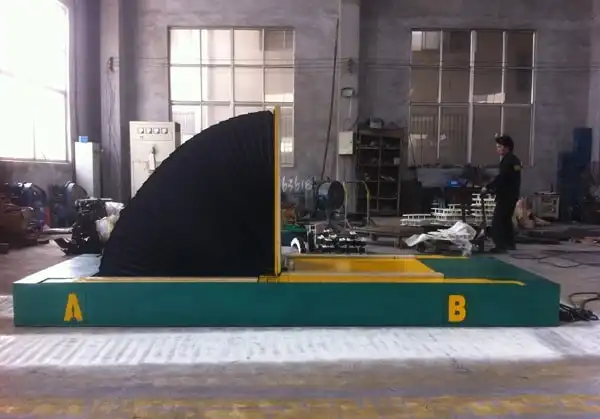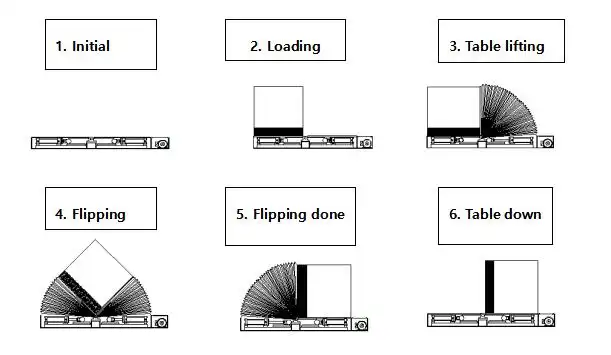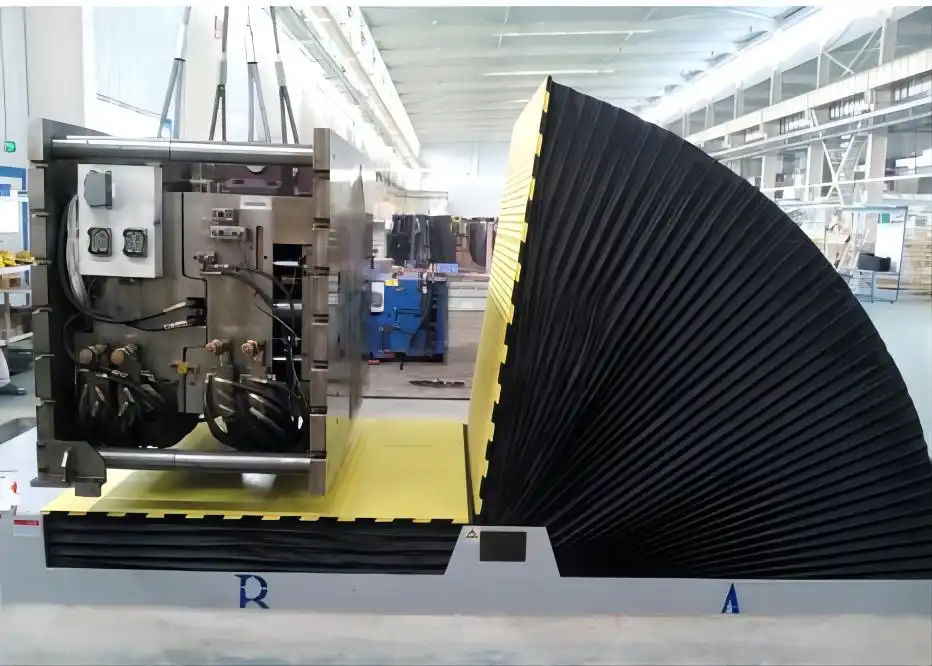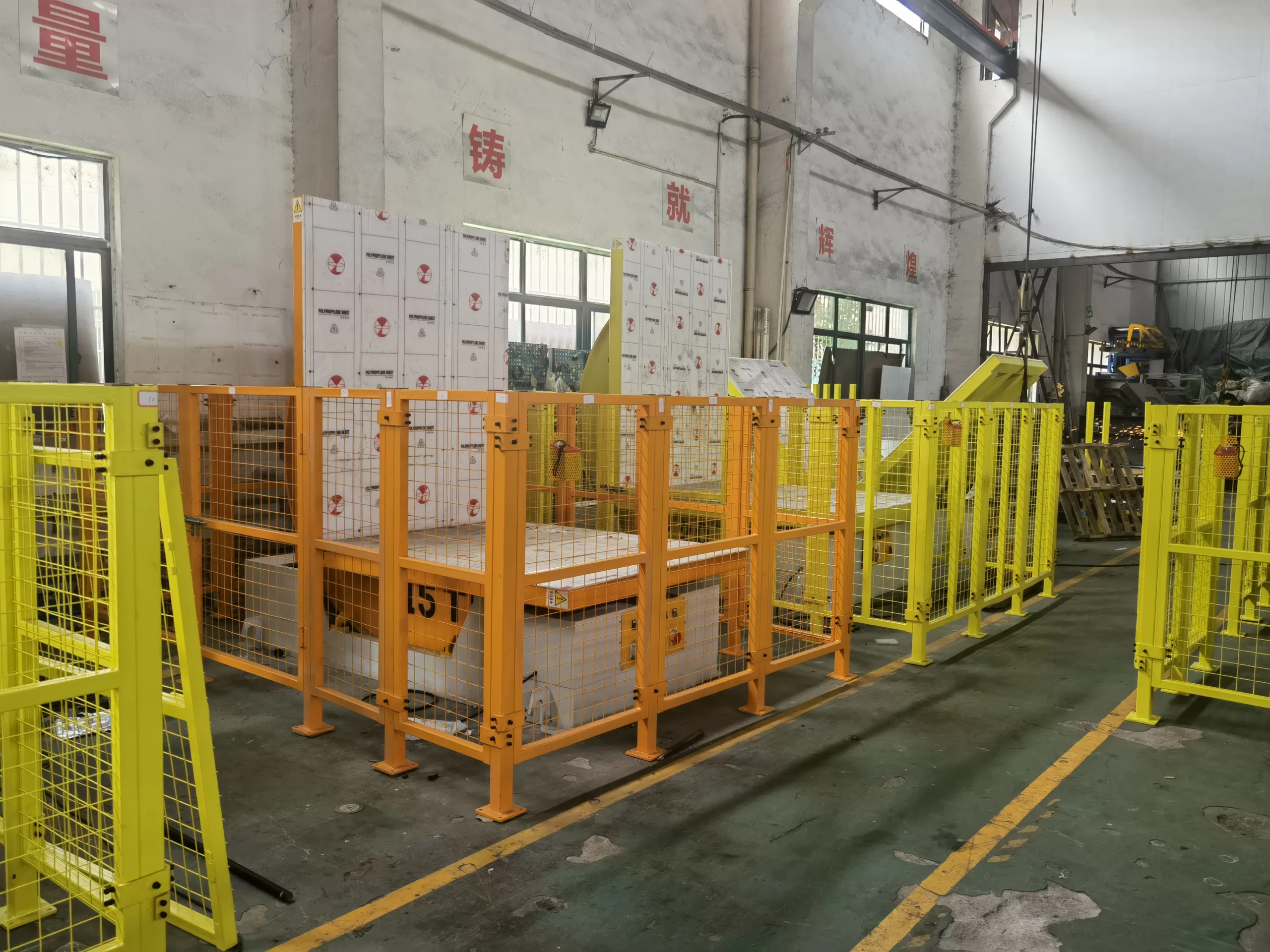Mold Flipper: How to Justify ROI for Indonesian Management and Finance Teams?
Handling heavy molds is a daily reality in many factories. But it's a reality filled with risk. I've seen teams use overhead cranes and chains to flip massive, expensive molds. It's a slow, clumsy process. One slip, one moment of inattention, and you have a disaster. A worker could be seriously injured, or a multi-thousand-dollar mold could be damaged beyond repair. This isn't just a problem; it's a ticking time bomb in your production line, causing hidden costs and constant anxiety for your floor managers.
To justify the ROI for a mold flipper to Indonesian management and finance teams, you must present a clear case built on three pillars: quantifiable safety improvements, direct operational cost reductions, and increased production uptime. Calculate the payback period by comparing the initial investment against the combined annual savings from eliminating accident-related costs, reducing labor hours for mold handling, and minimizing production downtime during mold maintenance and changeovers. Frame it not as an expense, but as an investment in operational stability and risk mitigation.

I know this conversation well. I've been on both sides of the table. I've been the engineer on the floor, worried about my team's safety. And I've been the factory owner, scrutinizing every line item on an investment proposal. You can't just say a machine is "safer" or "more efficient." You need to speak the language of business, the language of numbers. Let’s break down exactly how you can build an undeniable case for this essential piece of equipment.
You see your team using a crane to flip a heavy mold. The process seems to work. Nobody has been seriously hurt yet. But you know the risk is always there. This feeling is a heavy weight for any responsible manager. The real problem is the hidden costs that follow this risk. You are constantly paying for this unsafe method in ways that don't always appear on a balance sheet, such as lower team morale, micro-delays that add up, and the constant, low-level stress of potential disaster.
A mold flipper directly impacts safety by creating a controlled, predictable, and repeatable process for turning heavy objects. This systematic approach virtually eliminates the risk of sudden drops and uncontrolled movements, which are the primary causes of accidents. This, in turn, reduces hidden costs by preventing workplace injuries, expensive worker compensation claims, regulatory fines, and the high cost of repairing or replacing a damaged mold.

A Deeper Look at the True Cost of Manual Handling
When a finance team looks at a proposal for a mold flipper, they see a capital expenditure. It's a big number on a spreadsheet. Our job is to show them the bigger, hidden numbers they are already spending by not having one. These are the costs associated with sticking to the old, manual, or semi-automated methods like using cranes and chains. Let's break down these costs into clear categories.
The Direct and Indirect Costs of Unsafe Practices
Workplace accidents have obvious costs, but the indirect costs are often much larger. In a competitive market like Indonesia, where skilled labor is valuable, these costs can severely impact your profitability.
| Cost Category | Manual Crane & Chain Method | Dedicated Mold Flipper Method |
|---|---|---|
| Direct Costs | ||
| Medical Expenses | High risk of crush injuries, fractures. Potentially high medical bills. | Negligible risk. The machine handles the entire load safely. |
| Compensation Claims | One serious accident can lead to huge worker's comp claims and insurance premium hikes. | Extremely low probability, leading to stable or lower insurance costs. |
| Equipment Damage | High risk of dropping and cracking the mold. Cost of repair or full replacement. | Zero risk of dropping. The mold is securely clamped and rotated. |
| Legal & Fines | Potential for legal action and fines from safety authorities (like K3 in Indonesia). | Demonstrates proactive compliance with safety standards. |
| Indirect Costs | ||
| Lost Production Time | An accident stops the entire production line for investigation and cleanup. | No accident-related downtime. |
| Labor Inefficiency | Requires 2-3 skilled workers (crane operator, riggers) for one slow task. | Requires one operator for a fast, simple task. |
| Employee Morale | High-stress, dangerous work leads to anxiety and lower morale. | Workers feel valued and safe, leading to higher morale and productivity. |
| Employee Turnover | Higher turnover rates as workers seek safer environments. High costs for recruitment and training. | Higher employee retention. A safe workplace is a key benefit. |
When I started my own factory, one of the first things I budgeted for was proper material handling equipment. An engineer who used to work for me told me about a "near miss" at his previous job. A chain slipped while turning a large die. The die, worth over $50,000, crashed to the floor. It missed a worker by less than a meter. The company "saved" money by not buying a flipper, but they lost the die, lost a full day of production, and nearly lost an employee. The trust on the factory floor was shattered. These are the real-world costs we must make visible.
What specific metrics should we present to the finance team for a compelling ROI case?
You've prepared a presentation. You talk about safety. You talk about efficiency. But you see the finance manager's eyes glaze over. They are waiting for the numbers. If your proposal doesn't clearly show how this machine will pay for itself and start generating a positive return, it will be rejected. The challenge isn't convincing them that a mold flipper is useful; it's proving that it is a financially sound investment according to their specific criteria.
To create a compelling ROI case for your finance team, you must present four key metrics: Payback Period, Return on Investment (ROI), Net Present Value (NPV), and Total Cost of Ownership (TCO). Focus on quantifying annual savings from reduced labor, eliminated downtime, and prevention of mold damage. These hard numbers translate the operational benefits into the language of finance, making the investment decision clear and justifiable.

Speaking the Language of Finance: A Practical Guide
A financial team is trained to evaluate risk and return. Let's give them exactly what they need, using conservative estimates to build a case that is both powerful and believable.
Calculating Your Key Financial Metrics
We will use a hypothetical scenario. Let's assume the following:
- Mold Flipper Investment Cost: $30,000
- Manual Flipping Process: Requires 2 workers for 30 minutes.
- Mold Flipper Process: Requires 1 worker for 5 minutes.
- Average Molds Flipped per Day: 4
- Operational Days per Year: 300
- Skilled Labor Cost (fully burdened): $10/hour
- Downtime Cost per Hour: $500
- Estimated Annual Cost of Minor Mold Damage (manual): $2,000
1. Payback Period
This is the simplest metric. It answers the question: "How long until we get our money back?"
-
Labor Savings Calculation:
- Manual: 2 workers x 0.5 hours x $10/hr x 4 flips/day = $40/day
- Flipper: 1 worker x (5/60) hours x $10/hr x 4 flips/day = ~$3.33/day
- Daily Labor Savings: $40 - $3.33 = $36.67
- Annual Labor Savings: $36.67 x 300 days = $11,001
-
Downtime Savings Calculation:
- Manual Time per Flip: 30 minutes
- Flipper Time per Flip: 5 minutes
- Time Saved per Flip: 25 minutes
- Total Time Saved per Day: 25 min x 4 flips = 100 minutes
- Annual Downtime Savings: (100 min / 60 min/hr) x $500/hr x 300 days = $250,000 (Note: This is often the most significant saving)
-
Total Annual Savings: $11,001 (Labor) + $250,000 (Downtime) + $2,000 (Damage Prevention) = $263,001
-
Payback Period: $30,000 (Investment) / $263,001 (Annual Savings) = 0.11 years, or about 1.4 months.
This number alone is incredibly powerful.
2. Return on Investment (ROI)
This shows the total return over a period.
- ROI (1-year): [($263,001 Annual Savings - $30,000 Cost) / $30,000 Cost] x 100 = 776%
3. Total Cost of Ownership (TCO)
This metric is crucial for long-term thinking. A mold flipper has a low TCO. It requires minimal maintenance and consumes little energy compared to the potential costs it avoids.
| Cost Component | Year 1 | Year 2 | Year 3 |
|---|---|---|---|
| Initial Investment | $30,000 | $0 | $0 |
| Maintenance | $200 | $200 | $200 |
| Energy Costs | $300 | $300 | $300 |
| Total TCO | $30,500 | $500 | $500 |
| Avoided Costs (Savings) | $263,001 | $263,001 | $263,001 |
| Net Financial Impact | +$232,501 | +$262,501 | +$262,501 |
Presenting the data in this structured way moves the conversation from "we think this is a good idea" to "the data shows this is a profitable decision."
How does a mold flipper improve production efficiency and mold lifespan?
Every minute your production line is stopped for mold maintenance is a minute you are not making money. The traditional method of flipping molds with a crane is not just dangerous; it's incredibly slow and inefficient. This bottleneck slows down your entire maintenance cycle, which directly impacts your production capacity. Furthermore, every little bump and jolt during this clumsy process shortens the life of your very expensive molds.
A mold flipper improves production efficiency by reducing the time required to turn a mold from 30-40 minutes down to less than 5 minutes. This dramatic time saving minimizes line downtime and allows for faster maintenance cycles. It improves mold lifespan by ensuring a smooth, controlled rotation that eliminates the shock loads, impacts, and stress points caused by manual handling with cranes and chains, which prevents micro-fractures and extends the usable life of the tool.

From Bottleneck to Smooth Flow: A Deeper Dive
Let's look beyond just the time saved. The true impact of a mold flipper on efficiency is about transforming a chaotic, variable process into a standardized, predictable one. This is a core principle of modern manufacturing.
Process Standardization and Uptime
The biggest enemy of efficiency is variability. When you use a crane, the time it takes to flip a mold can vary wildly depending on the crane operator's availability, the skill of the riggers, and simple luck. A mold flipper removes this variability.
| Process Step | Manual Crane & Chain Method | Dedicated Mold Flipper Method |
|---|---|---|
| 1. Preparation | Find certified riggers and crane operator. Wait for crane to be free. Clear a large area. | The flipper is always ready. One operator walks up to the machine. |
| Time: | 10-20 minutes | 1 minute |
| 2. Rigging | Carefully attach chains/straps, ensuring balance. High skill required. | Load the mold onto the platform. Simple and fast. |
| Time: | 5-10 minutes | 2 minutes |
| 3. The Flip | Slow, careful lift, turn, and lower. High risk of swinging or impact. | Press a button. The machine performs a smooth 90 or 180-degree rotation. |
| Time: | 5-10 minutes | 1 minute |
| 4. Unrigging | Carefully detach chains. | Unclamp and remove the mold. |
| Time: | 5 minutes | 1 minute |
| Total Time: | 25-45 minutes | ~5 minutes |
This time difference is not just a small gain. If you perform this operation four times a day, you are saving over 1.5 hours of pure production downtime every single day. This is a massive increase in Overall Equipment Effectiveness (OEE).
Protecting Your Most Valuable Assets
Molds and dies are not just pieces of metal; they are high-precision, expensive assets. The way you handle them directly impacts their lifespan and the quality of the products they produce.
- Eliminating Shock Loads: When a crane lifts and lowers a mold, there are inevitable jolts and small impacts. A mold flipper applies even pressure and rotates on a smooth, hydraulic or mechanical axis. This prevents the formation of micro-fractures in the steel, which can lead to premature failure.
- Maintaining Precision: A small dent or warp from a dropped mold can ruin its precision. This means you start producing lower-quality parts, leading to more scrap and customer complaints. A mold flipper handles the asset with the care it requires.
I once consulted for a steel wire company in Southeast Asia. They were struggling with inconsistent product quality. After investigating, we found that their dies were being damaged during maintenance handling. They were using a forklift and chains. By investing in a proper die flipper, they not only made the process safer but also saw their scrap rate drop by 3%. The machine paid for itself in less than a year just from the reduction in wasted material. This is a story that resonates with any factory owner who values quality.
Why is a mold flipper a strategic asset for future growth in the Indonesian market?
Many managers see a mold flipper as a "nice-to-have" piece of auxiliary equipment. They see it as a solution to a single problem: turning molds. But this view is too narrow, especially in a rapidly modernizing and competitive market like Indonesia. The real challenge is not just to solve today's problems but to build a factory that is ready for tomorrow's demands. A factory that is stuck with old, unsafe, and inefficient processes will be left behind.
A mold flipper is a strategic asset because it is a foundational step towards automation, higher quality standards, and a modern factory culture. It signals to your employees, customers, and competitors that you are committed to safety, efficiency, and continuous improvement. This investment makes your facility more attractive to top talent, enables you to meet the stricter requirements of international clients, and builds a more resilient and scalable operation for future growth.

Building the Factory of the Future
Investing in a mold flipper is not just about flipping molds. It's about a mindset. It is a building block for a more advanced, competitive, and profitable operation. Let's explore how this single piece of equipment has a ripple effect across your entire business strategy.
Pillar 1: Enabling Automation and Industry 4.0
Your CEO, like Javier Morales in the example, wants to implement MES and IoT. But you cannot build a smart factory on a weak foundation.
- Standardization: Smart factories run on data and predictable processes. The mold flipper standardizes a key maintenance process, making it possible to integrate into a digital workflow. You can now accurately track maintenance times, schedule resources automatically, and feed reliable data into your MES.
- Foundation for Robotics: Once you have a machine that can predictably place a mold in a specific orientation, the next step towards automation (like using a robotic arm for cleaning or inspection) becomes much easier. The flipper is the bridge between manual labor and a fully automated cell.
Pillar 2: Attracting and Retaining Talent
The Indonesian workforce is becoming more skilled and has higher expectations. The best workers do not want to work in dangerous, outdated factories.
- Demonstrating Care: Investing in safety equipment is one of the most powerful ways to show your employees that you value their well-being. This builds loyalty and reduces costly employee turnover.
- Modern Workplace: A clean, modern, and safe factory floor is a powerful recruitment tool. It helps you attract and retain the high-skilled engineers and technicians you need to grow.
Pillar 3: Meeting Global Quality and Safety Standards
If you want to export your products or become a supplier for major international companies (in automotive, aerospace, etc.), you will face intense scrutiny.
- Audit-Proof Processes: When a potential client audits your factory, a chaotic, unsafe process like flipping molds with a crane is a major red flag. A mold flipper shows you have professional, documented, and safe procedures that meet global standards like ISO 9001 (quality) and ISO 45001 (safety).
- Brand Reputation: A commitment to modern technology and safety enhances your company's brand. You are no longer just a local manufacturer; you are a world-class operation. This strategic positioning allows you to command higher prices and win better contracts.
This investment is not an operational expense. It is a strategic enabler. It's a small step that opens the door to bigger opportunities.
My Insights
I remember standing in my first factory, watching my team. I had poured all my savings into this business. I saw two of my best guys using a crane to flip a heavy coil. My heart was in my throat the entire time. I had the engineering knowledge. I knew there was a better, safer way with a proper tilter. But I hesitated. I looked at the price of the machine and thought, "Maybe next year. We need that cash for raw materials right now."
Two weeks later, the inevitable happened. A chain slipped. The coil didn't fall far, but it swung hard and hit a rack of finished products, destroying thousands of dollars of inventory. Thankfully, no one was hurt, but it was a harsh lesson. I realized I wasn't saving money by delaying the investment; I was just gambling. And I was gambling with my employees' safety and my company's stability.
That day, I ordered the coil tilter. The real ROI wasn't just in the time saved or the inventory protected. The real ROI was peace of mind. It was knowing that I had eliminated a major risk from my operation. It was building a foundation of safety and professionalism that allowed us to grow with confidence. When you present your case to management, remember this: you are not just buying a machine. You are buying certainty. You are investing in a stable, safe, and professional future for the entire company.
Conclusion
Justifying a mold flipper is about translating safety and efficiency into financial terms. Present a clear ROI case with hard data to prove it is a profitable, strategic investment.




